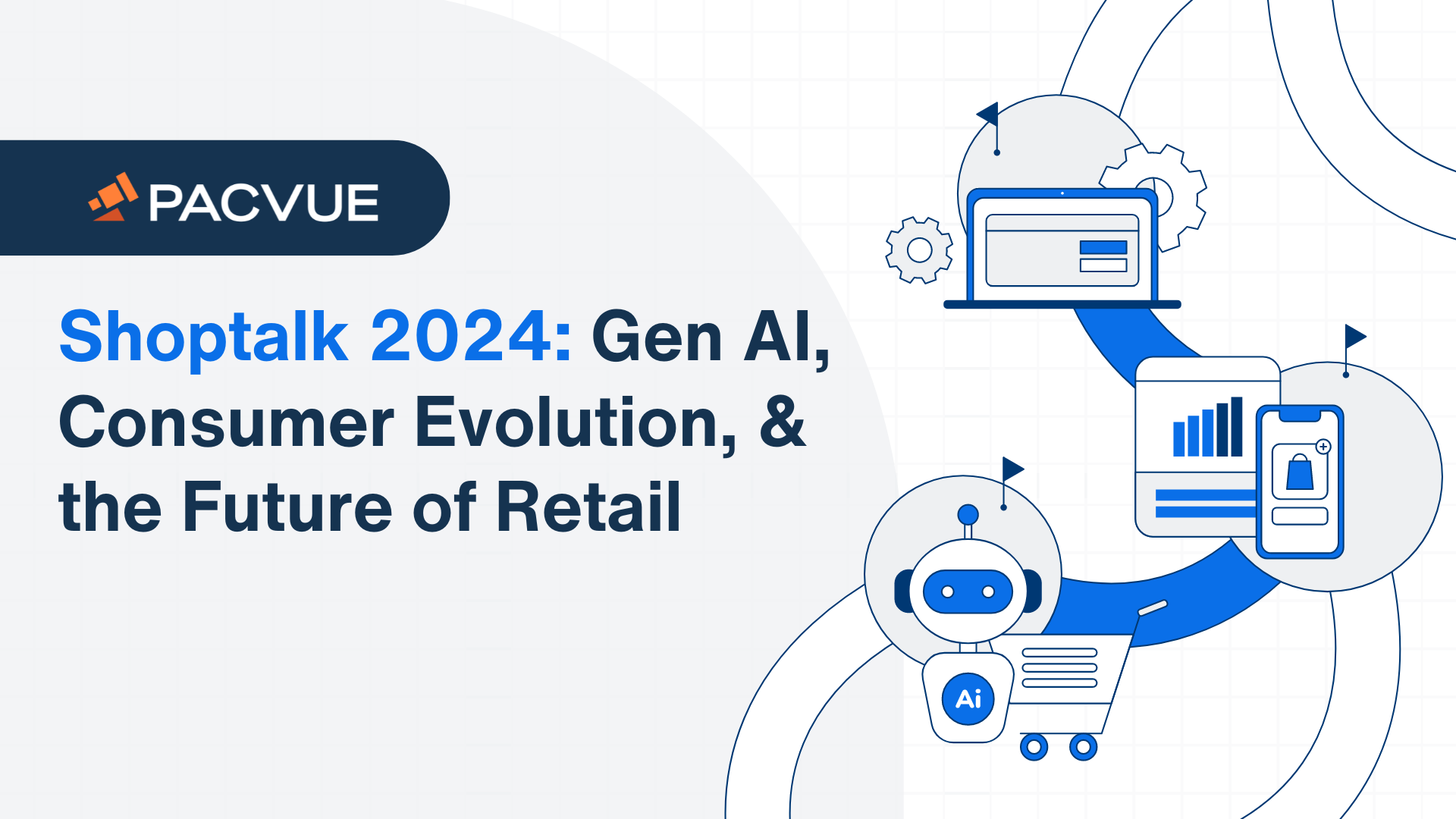That’s a wrap on Shoptalk 2024! Retail thought leaders and experts attended an array of sessions, but a few themes remained consistent: the evolving role generative AI on retail, ever-changing consumer preferences, and the latest in cutting-edge marketing technologies primed to make it easier for brands to increase profitability and market share. Whether you attended the conference or not, let’s break down the impact of these buzzworthy topics on retail media throughout 2024.
Generative AI in Retail
According to a new survey by NVIDIA, 98% of retailers plan to invest in generative AI in the next 18 months. Predictably, numerous sessions at this year’s event delved into the potential of leveraging new AI capabilities to streamline operations, enhance personalization, and even transform the in-store experience.
As we have seen over the past year, ChatGPT is quickly becoming a daily personal assistant and Generative AI has been introduced in a number of ways by eBay, Walmart, Instacart, Kroger, Target, and Amazon. The ever-growing list of retailers are using Generative AI to hyper-target customers, automate campaign listing creation, discover top keywords, and change creative assets. Brands and their agency partners are testing creative asset changes in real-time in the weeks and days leading up to “micro-seasons” or tentpole events. This enables brands to generate entirely new assets, such as images, copy, or video in less time and with more data.

Nuala O’Conner, Walmart and Fred Schoneberg, VentureFuel discussing how to manage the risks of AI
But one thought-provoking question lingered on everyone’s mind: ‘Is AI over-hyped?’ Ultimately, most agreed that AI can serve as a valuable tool for boosting productivity and enhancing customer experiences. In a Shoptalk session on “Understanding and Managing the Risks of Generative AI”, Walmart’s SVP & Chief Counsel, Digital Citizenship, Nuala O’Conner, and Fred Schoneberg, the Founder and CEO of VentureFuel, explained that Generative Ai is due to generate $7.9T of economic benefit annually. Publicis has further detailed that generative AI can drive down costs in the customer experience, supply chain, and back-end e-commerce. With AI, repetitive tasks can be automated, trends and patterns can be identified in consumer behavior, and data-driven decisions can be made to maximize ROAS. All of that said, some brands still struggle to measure the benefits of investing in AI. “Measuring the ROI of Generative AI can be a challenge,” Ting Chai, Chief Data Officer at Rakuten Group said in his session on “Pioneering Applications of Generative AI.” He added, “One way to really see the benefits is looking at every task you manually perform and how much time it takes to complete. Then see how much AI saves you to do the same tasks.”
Adapting to Evolving Customer Behaviors
New AI technology is evolving at a rapid pace, but so are overall consumer behaviors and preferences. Consumers in 2024 are more tech-savvy, more discerning and have greater choices than ever before. That old advertising adage that the customer is constantly changing has never been more accurate. So, how do you and your brand team keep up? Increased choice from an exploding number of emerging brands and marketplaces, and an educated consumer base have created more datapoints for brand teams to measure.
The rise of Social Commerce, TikTok Shops, Amazon influencer posts, shoppable reels and social shops, Shoppable TV, QR codes, and in-store displays are all new ways to do the same thing. The purchase journey has either been shortened by the nature of advertisers being in the customer’s living room or greatly expanded by adding the ever-increasing paradox of choice. Despite the proliferation of new online shopping options, a large amount of shopping is still done in stores, and brands need to keep the entirety of the shopping journey in mind. With all of these options, where does retail media play in the data journey? Because of the sheer amount of data, social commerce is predictably the biggest threat to existing retail media platforms. The amount of data available to these platforms to build out a profile of customer cohorts is massive and growing. Collen Aubrey, SVP of Ad Products and Technology at Amazon Ads, underscored the importance of retail media in enriching the customer journey, emphasizing its role as an additive rather than disruptive force. Aubrey further explained that shopping is a journey, not just a “find, click, and exit” series of steps. Therefore, Retail Media Networks need to be informed by the same signals that consumers are looking for.

Melissa Burdick, Pacvue and Abishake Subramanian, Walgreens answering questions about the evolving retail media landscape.
Pacvue’s Co-founder and President Melissa Burdick highlighted the importance of brand-shopper alignment in the ever-evolving retail media landscape in her conversation with Abishake (Abi) Subramanian from Walgreens. While every brand strives for this, it is only possible to stay in sync with what shoppers want by having internal alignment and agency alignment.
Tech Innovations Driving Retail
2024 is widely anticipated to be the biggest year to date for online shopping, with ecommerce sales predicted to reach $6.3 trillion worldwide. As Walmart and Amazon vie for first place in the marketplace race, brands are intensifying efforts to craft immersive and seamless experiences that captivate and retain consumers while driving increased spending. One key aspect of winning the rapidly evolving customer experience online will be cracking the code of incrementality. The major challenge brands face here is how to connect fragmented data across sales channels and often siloed teams within eCommerce departments.

Shoptalk Panel featuring Anthony Lye from Amplience, Melissa Burdick from Pacvue, Assaf Baciu representing Persado, and Trevor Testwuide from Measured.
Brands that will win at incrementality will focus on consolidating data across sources into a single tool to help inform forecasting and decisions on supply chain, advertising spend, and pricing. Platforms like Pacvue, which consolidate commerce and retail media data and provide the ability to integrate external sources such as Profitero, will allow brands to have a single source of truth to work from.
Having this base layer of data is crucial for solving for incrementality but also allows brands to take advantage of adding layers of AI to inform decisions and strategies. With solid data and sophisticated AI, brands can understand their actual market share ownership of a category and implement strategies to target customers cost-effectively.
This proactive technology adoption not only sustains short-term competitiveness but also fosters long-term success in a digital-centric landscape. By staying informed about the latest tech solutions and trends, brands can unlock new opportunities for growth, efficiency, and customer satisfaction, ultimately driving success in the digital age.
Kevin Lewis, Chief Growth Officer, Alimentation Couche-Tard summed it up well in his session ‘Leveraging AI to Scale Personalization’ with the analogy ‘If predictive AI is cake, gen AI is the icing.’ He added that the more we can bring data to the table, the better we can get at having products on the shelves that consumers want and drive a personalized shopping experience.
Conclusion
From understanding consumer behaviors and the evolving shopping journey to leveraging new marketing technologies and embracing AI for content creation, Shoptalk covered a broad spectrum of topics crucial for brands navigating the digital landscape. Embracing these insights empowers brands to adapt to evolving consumer expectations, foster growth, and stay competitive in the dynamic retail landscape.
Learn More:
Contact us today to learn more about the Pacvue Platform and how our team can help scale your brand across dozens of retailers.













